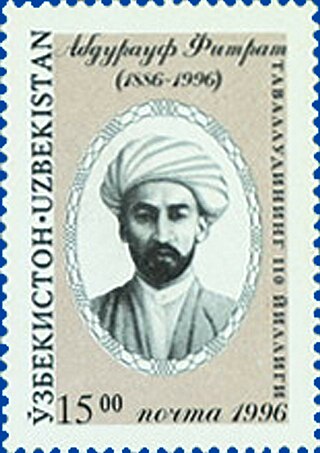
Central Asia is a subregion of Asia that stretches from the Caspian Sea in the southwest and European Russia in the northwest to Western China and Mongolia in the east, and from Afghanistan and Iran in the south to Siberia in the north. It includes Kazakhstan, Kyrgyzstan, Tajikistan, Turkmenistan, and Uzbekistan. The countries as a group are also colloquially referred to as the "-stans" as all have names ending with the Persian suffix "-stan" in both respective native languages and most other languages. Central Asia borders Eastern Europe to the west, West Asia to the southwest, South Asia to the southeast, North Asia to the north, and East Asia to the east.

Persian, also known by its endonym Farsi, is a Western Iranian language belonging to the Iranian branch of the Indo-Iranian subdivision of the Indo-European languages. Persian is a pluricentric language predominantly spoken and used officially within Iran, Afghanistan, and Tajikistan in three mutually intelligible standard varieties, respectively Iranian Persian, Dari Persian, and Tajiki Persian. It is also spoken natively in the Tajik variety by a significant population within Uzbekistan, as well as within other regions with a Persianate history in the cultural sphere of Greater Iran. It is written officially within Iran and Afghanistan in the Persian alphabet, a derivative of the Arabic script, and within Tajikistan in the Tajik alphabet, a derivative of the Cyrillic script.
The Uzbeks are a Turkic ethnic group native to the wider Central Asian region, being among the largest Turkic ethnic groups in the area. They comprise the majority population of Uzbekistan, next to Kazakh and Karakalpak minorities, and also form minority groups in Afghanistan, Tajikistan, Kyrgyzstan, Kazakhstan, Turkmenistan, Russia, and China. Uzbek diaspora communities also exist in Turkey, Saudi Arabia, United States, Ukraine, Pakistan, and other countries.

Uzbek, formerly known as Turki, is a Karluk Turkic language spoken by Uzbeks. It is the official and national language of Uzbekistan and formally succeeded Chagatai, an earlier Karluk language also known as "Turki", as the literary language of Uzbekistan in the 1920s.

Kyrgyz is a Turkic language of the Kipchak branch spoken in Central Asia. Kyrgyz is the official language of Kyrgyzstan and a significant minority language in the Kizilsu Kyrgyz Autonomous Prefecture in Xinjiang, China and in the Gorno-Badakhshan Autonomous Region of Tajikistan. There is a very high level of mutual intelligibility between Kyrgyz, Kazakh, and Altay. A dialect of Kyrgyz known as Pamiri Kyrgyz is spoken in north-eastern Afghanistan and northern Pakistan. Kyrgyz is also spoken by many ethnic Kyrgyz through the former Soviet Union, Afghanistan, Turkey, parts of northern Pakistan, and Russia.

Azerbaijani or Azeri, also referred to as Azeri Turkic or Azeri Turkish, is a Turkic language from the Oghuz sub-branch. It is spoken primarily by the Azerbaijani people, who live mainly in the Republic of Azerbaijan, where the North Azerbaijani variety is spoken, while Iranian Azerbaijanis in the Azerbaijan region of Iran, speak the South Azerbaijani variety. Azerbaijani has official status in the Republic of Azerbaijan and Dagestan, but it does not have official status in Iran, where the majority of Iranian Azerbaijani people live. Azerbaijani is also spoken to lesser varying degrees in Azerbaijani communities of Georgia and Turkey and by diaspora communities, primarily in Europe and North America.

Chagatai, also known as Turki, Eastern Turkic, or Chagatai Turkic, is an extinct Turkic language that was once widely spoken across Central Asia. It remained the shared literary language in the region until the early 20th century. It was used across a wide geographic area including western or Russian Turkestan, Eastern Turkestan, Crimea, the Volga region, etc. Literary Chagatai is the predecessor of the modern Karluk branch of Turkic languages, which includes Uzbek and Uyghur. Turkmen, which is not within the Karluk branch but in the Oghuz branch of Turkic languages, was nonetheless heavily influenced by Chagatai for centuries.

Turkmen is a Turkic language of the Oghuz branch spoken by the Turkmens of Central Asia. It has an estimated 4.3 million native speakers in Turkmenistan, and a further 719,000 speakers in northeastern Iran and 1.5 million people in northwestern Afghanistan, where it has no official status. Turkmen is also spoken to lesser varying degrees in Turkmen communities of Uzbekistan and Tajikistan and by diaspora communities, primarily in Turkey and Russia.

Tajik, or Tajiki Persian, also called Tajiki, is the variety of Persian spoken in Tajikistan and Uzbekistan by Tajiks. It is closely related to neighbouring Dari of Afghanistan with which it forms a continuum of mutually intelligible varieties of the Persian language. Several scholars consider Tajik as a dialectal variety of Persian rather than a language on its own. The popularity of this conception of Tajik as a variety of Persian was such that, during the period in which Tajik intellectuals were trying to establish Tajik as a language separate from Persian, prominent intellectual Sadriddin Ayni counterargued that Tajik was not a "bastardised dialect" of Persian. The issue of whether Tajik and Persian are to be considered two dialects of a single language or two discrete languages has political aspects to it.

Uyghur or Uighur is a Turkic language written in a Uyghur Perso-Arabic script with 8–13 million speakers, spoken primarily by the Uyghur people in the Xinjiang Uyghur Autonomous Region of Western China. Apart from Xinjiang, significant communities of Uyghur speakers are also located in Kazakhstan, Pakistan, Kyrgyzstan, and Uzbekistan, and various other countries have Uyghur-speaking expatriate communities. Uyghur is an official language of the Xinjiang Uyghur Autonomous Region; it is widely used in both social and official spheres, as well as in print, television, and radio. Other ethnic minorities in Xinjiang also use Uyghur as a common language.

Magtymguly Pyragy, born Magtymguly, was a Turkmen spiritual leader, philosophical poet, Sufi and traveller who is considered the most famous figure in Turkmen literary history.

Nogai also known as Noğay, Noghay, Nogay, or Nogai Tatar, is a Turkic language spoken in Southeastern European Russia, Kazakhstan, Uzbekistan, Ukraine, Bulgaria, Romania and Turkey. It is the ancestral language of the Nogais. As a member of the Kipchak branch, it is closely related to Kazakh, Karakalpak and Crimean Tatar. In 2014 the first Nogai novel was published, written in the Latin alphabet.

'Ali-Shir Nava'i, also known as Nizām-al-Din ʿAli-Shir Herawī was a Timurid poet, writer, statesman, linguist, Hanafi Maturidi mystic and painter who was the greatest representative of Chagatai literature.

The Uzbek language has been written in various scripts: Latin, Cyrillic and Arabic. The language traditionally used Arabic script, but the official Uzbek government under the Soviet Union started to use Cyrillic in 1940, which is when widespread literacy campaigns were initiated by the Soviet government across the Union. In 1992, Latin script was officially reintroduced in Uzbekistan along with Cyrillic. In the Xinjiang region of China, some Uzbek speakers write using Cyrillic, others with an alphabet based on the Uyghur Arabic alphabet. Uzbeks of Afghanistan also write the language using Arabic script, and the Arabic Uzbek alphabet is taught at some schools.

Central Asian Arabic or Jugari Arabic refers to a set of four closely-related varieties of Arabic currently facing extinction and spoken predominantly by Arab communities living in portions of Central Asia. These varieties are Bactrian Arabic, Bukhara Arabic, Qashqa Darya Arabic, and Khorasani Arabic.

Latinisation or latinization was a campaign in the Soviet Union to adopt the Latin script during the 1920s and 1930s. Latinisation aimed to replace Cyrillic and traditional writing systems for all languages of the Soviet Union with Latin or Latin-based systems, or introduce them for languages that did not have a writing system. Latinisation began to slow in the Soviet Union during the 1930s and a Cyrillisation campaign was launched instead. Latinization had effectively ended by the 1940s. Most of these Latin alphabets are defunct and several contain multiple letters that do not have Unicode support as of 2023.

Abdurauf Fitrat was an Uzbek author, journalist, politician and public intellectual in Central Asia under Russian and Soviet rule.

The spread of the Latin script has a long history, from its archaic beginnings in Latium to its rise as the dominant writing system in modernity. The ancestors of Latin letters are found in the Phoenician, Greek, and Etruscan alphabets. As the Roman Empire expanded in classical antiquity, the Latin script and language spread along with its conquests, and remained in use in Italy, Iberia, and Western Europe after the Western Roman Empire's disappearance. During the early and high Middle Ages, the script was spread by Christian missionaries and rulers, replacing the indigenous writing systems of Central Europe, Northern Europe, and the British Isles.
Turkmen literature comprises oral compositions and written texts in the Old Oghuz Turkic and Turkmen languages. The Turkmens are direct descendants of the Oghuz Turks, who were a western Turkic people, who formed the Oghuz branch of the Turkic language family.
Uyghur or Uighur literature comprises oral compositions and written texts in the Uyghur language, a Turkic language used primarily by the Uyghur people in the Xinjiang Uyghur Autonomous Region of the People's Republic of China.

















